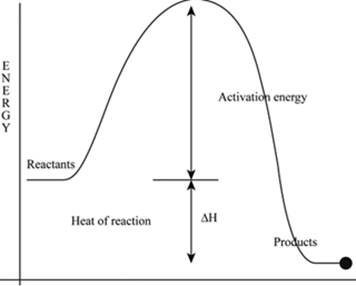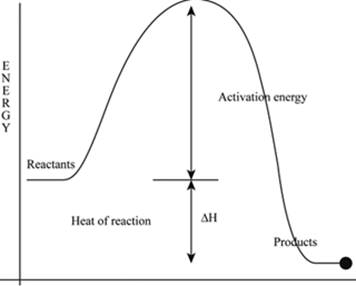
CHEMISTRY-TEXT
8th Edition
ISBN: 9780134856230
Author: Robinson
Publisher: PEARSON
expand_more
expand_more
format_list_bulleted
Question
Chapter 14, Problem 14.100SP
Interpretation Introduction
(a)
Interpretation:
The activation energy needs to be calculated for the following first order reaction:
Concept introduction:
Activation energy is defined as a minimum energy required for the start of any reaction or minimum energy possessed by a chemical system for a reaction to take place.

Interpretation Introduction
(b)
Interpretation:
The activation energy using the data collected from the following first order reaction needs to be determined:
Concept introduction:
Activation energy is defined as a minimum energy required for the start of any reaction or minimum energy possessed by a chemical system for a reaction to take place.

Expert Solution & Answer
Want to see the full answer?
Check out a sample textbook solution
Students have asked these similar questions
Synthesis of 1-metilbenzotriazole from 1,2-diaminobenceno.
Synthesis of 1-metilbenzotriazole.
Indicate the formula of the compound, that is the result of the N-
alquilación (nucleofílic substitution), in which an additional lateral
chain was formed (NH-CH2-COOMe).
F3C.
CF3
NH
NH2
Br о
OMe
K2CO3, DABCO, DMF
Chapter 14 Solutions
CHEMISTRY-TEXT
Ch. 14 - Prob. 14.1PCh. 14 - Prob. 14.2ACh. 14 - The rate law for the reaction...Ch. 14 - Prob. 14.4ACh. 14 - The initial rates listed in the following...Ch. 14 - Prob. 14.6ACh. 14 - Prob. 14.7PCh. 14 - Prob. 14.8ACh. 14 - Prob. 14.9PCh. 14 - Prob. 14.10A
Ch. 14 - Prob. 14.11PCh. 14 - Prob. 14.12ACh. 14 - Prob. 14.13PCh. 14 - Prob. 14.14ACh. 14 - Consider the first-order decomposition of H2O2...Ch. 14 - Prob. 14.16ACh. 14 - Hydrogen iodide gas decomposes at 410 °C:...Ch. 14 - Prob. 14.18ACh. 14 - Thereaction NO2(g)+CO(g)NO(g)+CO2(g) occurs in one...Ch. 14 - Prob. 14.20ACh. 14 - Prob. 14.21PCh. 14 - Apply 13.22 The rate of the reaction...Ch. 14 - Prob. 14.23PCh. 14 - Prob. 14.24ACh. 14 - Prob. 14.25PCh. 14 - Prob. 14.26ACh. 14 - Prob. 14.27PCh. 14 - Prob. 14.28ACh. 14 - The following mechanism has been proposed for the...Ch. 14 - Prob. 14.30ACh. 14 - Prob. 14.31PCh. 14 - Draw a potential energy diagram for the mechanism...Ch. 14 - Prob. 14.33PCh. 14 - Given the mechanism for an enzyme-catalyzed...Ch. 14 - Prob. 14.35PCh. 14 - Prob. 14.36PCh. 14 - At high substrate concentrations, the rate...Ch. 14 - Chymotrypsin is a digestive enzyme component of...Ch. 14 - Prob. 14.39CPCh. 14 - Prob. 14.40CPCh. 14 - Prob. 14.41CPCh. 14 - Prob. 14.42CPCh. 14 - Prob. 14.43CPCh. 14 - Prob. 14.44CPCh. 14 - Prob. 14.45CPCh. 14 - Prob. 14.46CPCh. 14 - Prob. 14.47CPCh. 14 - Prob. 14.48CPCh. 14 - Prob. 14.49CPCh. 14 - Use the data in Table 13.1 to calculate the...Ch. 14 - 13.50 Use the data in Table 13.1 to calculate the...Ch. 14 - Prob. 14.52SPCh. 14 - Prob. 14.53SPCh. 14 - From the plot of concentrationtime data in Figure...Ch. 14 - Prob. 14.55SPCh. 14 - Prob. 14.56SPCh. 14 - Prob. 14.57SPCh. 14 - Prob. 14.58SPCh. 14 - Prob. 14.59SPCh. 14 - Prob. 14.60SPCh. 14 - Prob. 14.61SPCh. 14 - Prob. 14.62SPCh. 14 - Prob. 14.63SPCh. 14 - Prob. 14.64SPCh. 14 - Prob. 14.65SPCh. 14 - Prob. 14.66SPCh. 14 - Prob. 14.67SPCh. 14 - The oxidation of iodide ion by hydrogen peroxide...Ch. 14 - Prob. 14.69SPCh. 14 - At 500 °C, cyclopropane (C3H6) rearranges to...Ch. 14 - The rearrangement of methyl isonitrile (CH3NC) to...Ch. 14 - What is the half-life (in minutes) of the reaction...Ch. 14 - Prob. 14.73SPCh. 14 - Prob. 14.74SPCh. 14 - Hydrogen iodide decomposes slowly to H2 and I2 at...Ch. 14 - What is the half-life (in minutes) of the reaction...Ch. 14 - Prob. 14.77SPCh. 14 - At 25 °C, the half-life of a certain first-order...Ch. 14 - The decomposition of N2O5 is a first-order...Ch. 14 - Prob. 14.80SPCh. 14 - Prob. 14.81SPCh. 14 - Prob. 14.82SPCh. 14 - Consider the following concentration-time data for...Ch. 14 - Trans-cycloheptene (C7H12), a strained cyclic...Ch. 14 - Thelight-stimulatedconversionof 11-cis-retinalto...Ch. 14 - Why don't all collisions between reactant...Ch. 14 - Prob. 14.87SPCh. 14 - Prob. 14.88SPCh. 14 - Prob. 14.89SPCh. 14 - The values of Ea=183 kJ/mol and E=9 kJ/mol have...Ch. 14 - Prob. 14.91SPCh. 14 - Consider three reactions with different values of...Ch. 14 - Prob. 14.93SPCh. 14 - Rate constants for the reaction...Ch. 14 - Prob. 14.95SPCh. 14 - Prob. 14.96SPCh. 14 - Prob. 14.97SPCh. 14 - If the rate of a reaction increases by a factor of...Ch. 14 - Prob. 14.99SPCh. 14 - Prob. 14.100SPCh. 14 - Rate constants for the reaction...Ch. 14 - Prob. 14.102SPCh. 14 - Poly(ethylene terephthalate) is a synthetic...Ch. 14 - Prob. 14.104SPCh. 14 - Prob. 14.105SPCh. 14 - Prob. 14.106SPCh. 14 - The following mechanism has been proposed for the...Ch. 14 - Prob. 14.108SPCh. 14 - Prob. 14.109SPCh. 14 - The thermal decomposition of nitryl chloride,...Ch. 14 - The substitution reactions of molybdenum...Ch. 14 - The reaction 2NO2(g)+F2(g)2NO2F(g) has a second...Ch. 14 - The decomposition of ozone in the upper atmosphere...Ch. 14 - Prob. 14.114SPCh. 14 - The following mechanism has been proposed for the...Ch. 14 - Prob. 14.116SPCh. 14 - Prob. 14.117SPCh. 14 - Prob. 14.118SPCh. 14 - Prob. 14.119SPCh. 14 - Prob. 14.120SPCh. 14 - Prob. 14.121SPCh. 14 - Prob. 14.122SPCh. 14 - Prob. 14.123SPCh. 14 - Consider the reaction 2NO(g)+O2(g)2NO2(g) . The...Ch. 14 - Concentration-time data for the conversion of A...Ch. 14 - Prob. 14.126MPCh. 14 - Prob. 14.127MPCh. 14 - Prob. 14.128MPCh. 14 - Prob. 14.129MPCh. 14 - Prob. 14.130MPCh. 14 - Prob. 14.131MPCh. 14 - Prob. 14.132MPCh. 14 - Prob. 14.133MPCh. 14 - Prob. 14.134MPCh. 14 - Polytetrafluoroethylene (Teflon) decomposes when...Ch. 14 - The reaction A is first order in the reactant A...Ch. 14 - Prob. 14.137MPCh. 14 - A 1.50 L sample of gaseous HI having a density of...Ch. 14 - The rate constant for the decomposition of gaseous...Ch. 14 - The rate constant for the first-order...Ch. 14 - Prob. 14.141MPCh. 14 - Prob. 14.142MPCh. 14 - At 791 K and relatively low pressures, the...
Knowledge Booster
Learn more about
Need a deep-dive on the concept behind this application? Look no further. Learn more about this topic, chemistry and related others by exploring similar questions and additional content below.Similar questions
- Identify the mechanism through which the following reaction will proceed and draw the major product. Part 1 of 2 Br KOH EtOH Through which mechanism will the reaction proceed? Select the single best answer. E1 E2 neither Part: 1/2 Part 2 of 2 Draw the major product formed as a result of the reaction. Click and drag to start drawing a structure. Xarrow_forwardWhat is single-point calibration? Provide an example.arrow_forwardDraw the major product formed via an E1 pathway.arrow_forward
- Part 9 of 9 Consider the products for the reaction. Identify the major and minor products. HO Cl The E stereoisomer is the major product and the Z stereoisomer is the minor product ▼ S major product minor productarrow_forwardConsider the reactants below. Answer the following questions about the reaction mechanism and products. HO Clarrow_forwardjulietteyep@gmail.com X YSCU Grades for Juliette L Turner: Orc X 199 A ALEKS - Juliette Turner - Modul X A ALEKS - Juliette Turner - Modul x G butane newman projection - Gox + www-awa.aleks.com/alekscgi/x/Isl.exe/10_u-IgNslkr7j8P3jH-IBxzaplnN4HsoQggFsejpgqKoyrQrB2dKVAN-BcZvcye0LYa6eXZ8d4vVr8Nc1GZqko5mtw-d1MkNcNzzwZsLf2Tu9_V817y?10Bw7QYjlb il Scribbr citation APA SCU email Student Portal | Main Ryker-Learning WCU-PHARM D MySCU YSCU Canvas- SCU Module 4: Homework (Ch 9-10) Question 28 of 30 (1 point) | Question Attempt: 1 of Unlimited H₂SO heat OH The mechanism of this reaction involves two carbocation intermediates, A and B. Part 1 of 2 KHSO 4 rearrangement A heat B H₂O 2 OH Draw the structure of A. Check Search #t m Save For Later Juliet Submit Assignm 2025 McGraw Hill LLC. All Rights Reserved. Terms of Use | Privacy Center | Accessarrow_forward
- The electrons flow from the electron-rich atoms of the nucleophile to the electrons poor atoms of the alkyl halide. Identify the electron rich in the nucleophile. Enter the element symbol only, do not include any changes.arrow_forwardHello, I am doing a court case analysis in my Analytical Chemistry course. The case is about a dog napping and my role is prosecution of the defendant. I am tasked in the Area of Expertise in Neutron Activation and Isotopic Analysis. Attached is the following case study reading of my area of expertise! The landscaping stone was not particularly distinctive in its decoration but matched both the color and pattern of the Fluential’s landscaping stone as well as the stone in the back of the recovered vehicle. Further analysis of the stone was done using a technique called instrumental neutron activation analysis. (Proceed to Neutron Activation data) Photo Notes: Landscaping stone recovered in vehicle. Stone at Fluential’s home is similar inappearance. Finally, the white paint on the brick was analyzed using stable isotope analysis. The brick recovered at the scene had smeared white paint on it. A couple of pieces of brick in the back of the car had white paint on them. They…arrow_forwardCite the stability criteria of an enamine..arrow_forward
arrow_back_ios
SEE MORE QUESTIONS
arrow_forward_ios
Recommended textbooks for you
- Chemistry: Matter and ChangeChemistryISBN:9780078746376Author:Dinah Zike, Laurel Dingrando, Nicholas Hainen, Cheryl WistromPublisher:Glencoe/McGraw-Hill School Pub Co
 Chemistry: The Molecular ScienceChemistryISBN:9781285199047Author:John W. Moore, Conrad L. StanitskiPublisher:Cengage Learning
Chemistry: The Molecular ScienceChemistryISBN:9781285199047Author:John W. Moore, Conrad L. StanitskiPublisher:Cengage Learning ChemistryChemistryISBN:9781305957404Author:Steven S. Zumdahl, Susan A. Zumdahl, Donald J. DeCostePublisher:Cengage Learning
ChemistryChemistryISBN:9781305957404Author:Steven S. Zumdahl, Susan A. Zumdahl, Donald J. DeCostePublisher:Cengage Learning 
 Chemistry: Principles and PracticeChemistryISBN:9780534420123Author:Daniel L. Reger, Scott R. Goode, David W. Ball, Edward MercerPublisher:Cengage Learning
Chemistry: Principles and PracticeChemistryISBN:9780534420123Author:Daniel L. Reger, Scott R. Goode, David W. Ball, Edward MercerPublisher:Cengage Learning Chemistry: An Atoms First ApproachChemistryISBN:9781305079243Author:Steven S. Zumdahl, Susan A. ZumdahlPublisher:Cengage Learning
Chemistry: An Atoms First ApproachChemistryISBN:9781305079243Author:Steven S. Zumdahl, Susan A. ZumdahlPublisher:Cengage Learning

Chemistry: Matter and Change
Chemistry
ISBN:9780078746376
Author:Dinah Zike, Laurel Dingrando, Nicholas Hainen, Cheryl Wistrom
Publisher:Glencoe/McGraw-Hill School Pub Co

Chemistry: The Molecular Science
Chemistry
ISBN:9781285199047
Author:John W. Moore, Conrad L. Stanitski
Publisher:Cengage Learning

Chemistry
Chemistry
ISBN:9781305957404
Author:Steven S. Zumdahl, Susan A. Zumdahl, Donald J. DeCoste
Publisher:Cengage Learning


Chemistry: Principles and Practice
Chemistry
ISBN:9780534420123
Author:Daniel L. Reger, Scott R. Goode, David W. Ball, Edward Mercer
Publisher:Cengage Learning

Chemistry: An Atoms First Approach
Chemistry
ISBN:9781305079243
Author:Steven S. Zumdahl, Susan A. Zumdahl
Publisher:Cengage Learning
Kinetics: Initial Rates and Integrated Rate Laws; Author: Professor Dave Explains;https://www.youtube.com/watch?v=wYqQCojggyM;License: Standard YouTube License, CC-BY